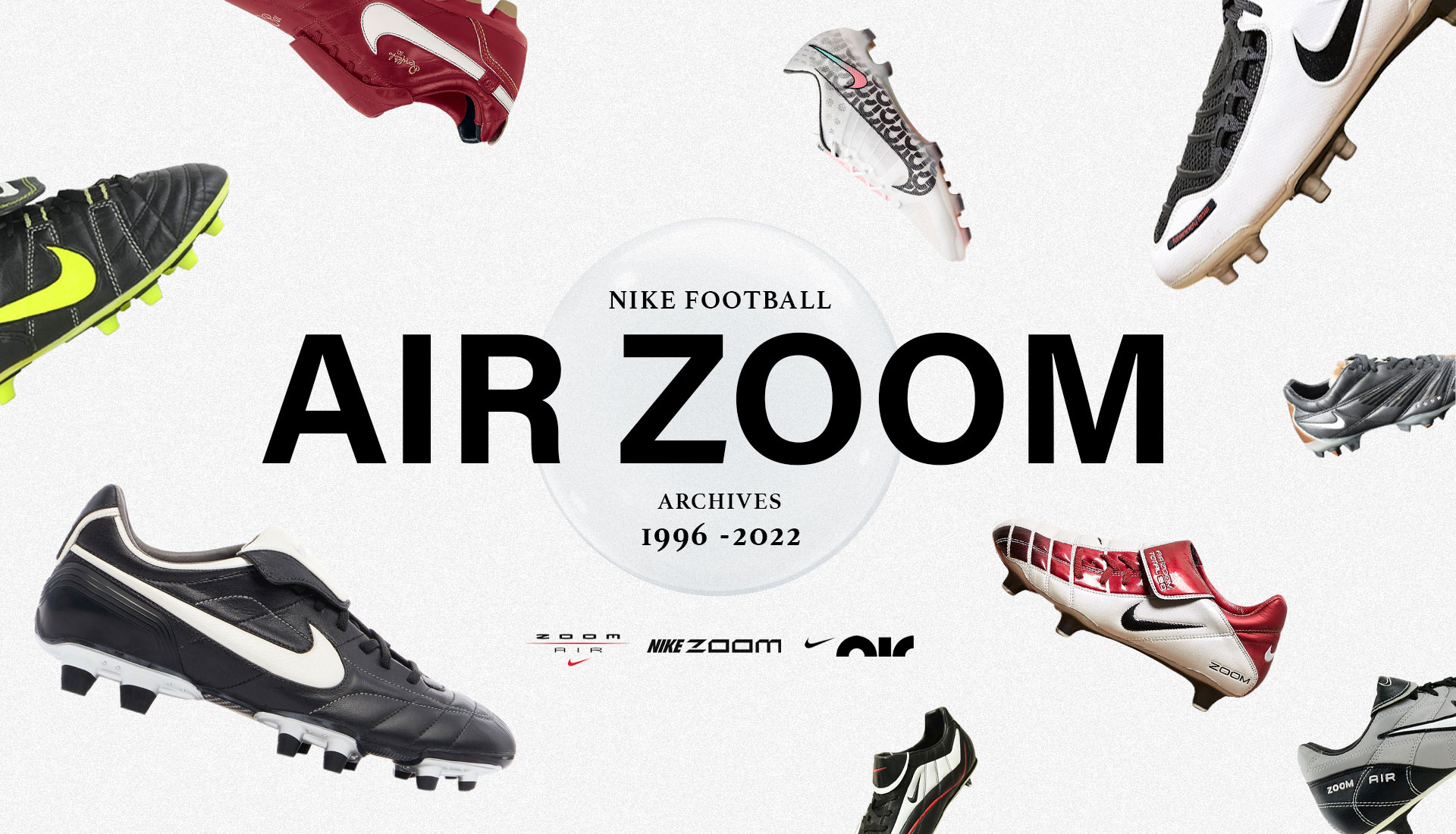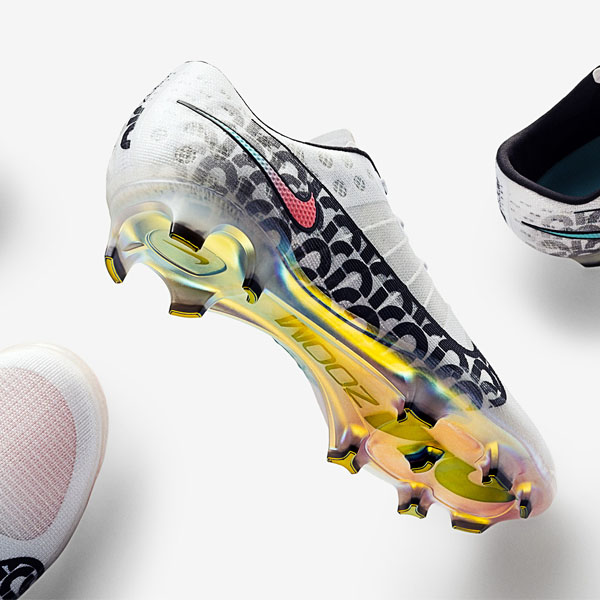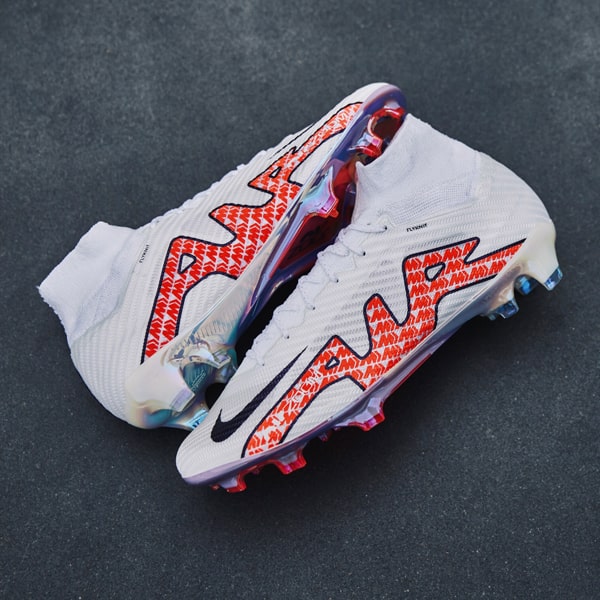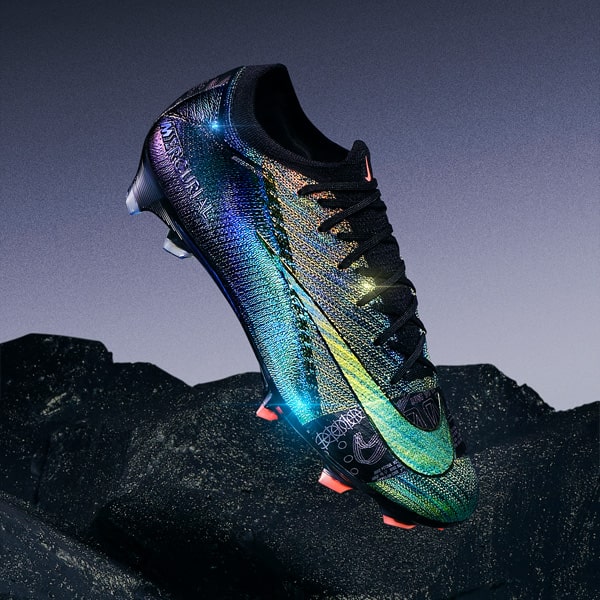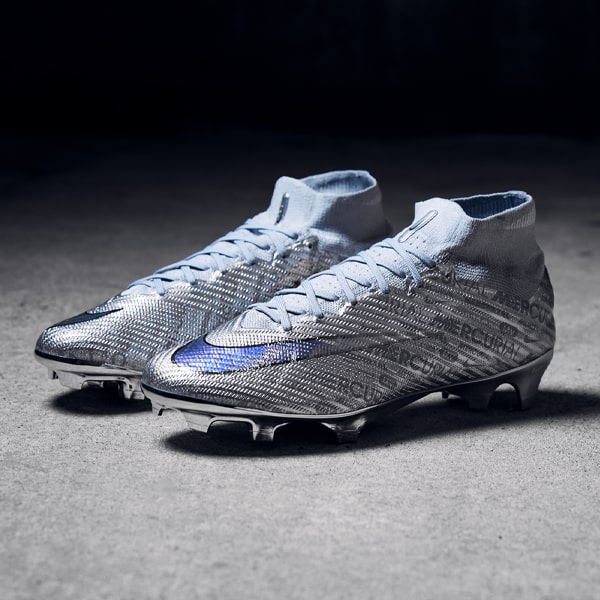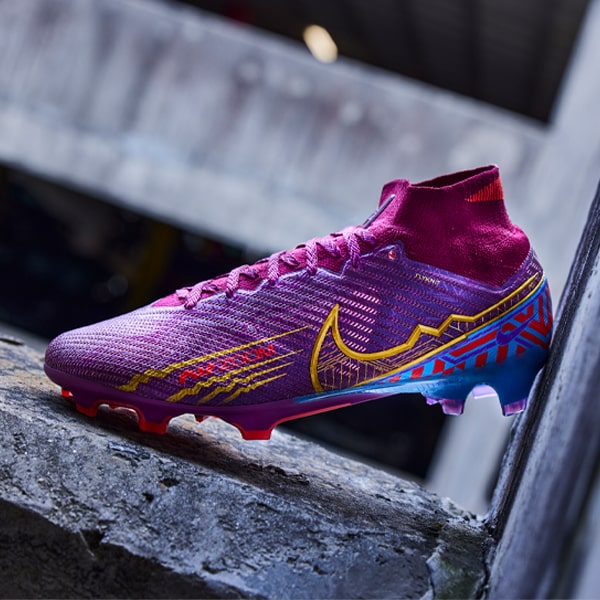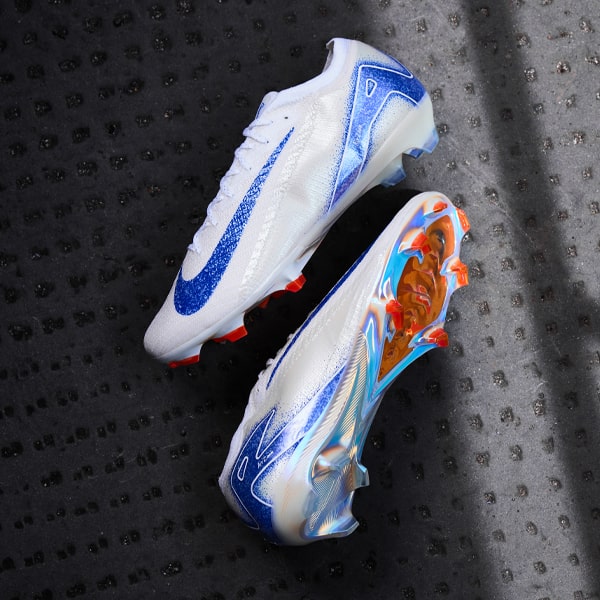With Nike unveiling the revolutionary new Air Zoom Mercurial, we’re taking the opportunity to look back at the complete history of Nike’s Zoom Air in football.
Air is the most recognisable of all of Nike’s technologies; essentially it consists of pressurised air in a tough yet flexible bag to provide lightweight cushioning and spring without compromising structure. With each step, pressure is applied to the Air units, which absorb and release energy as you step off.
Originally debuting way back in 1979, Nike has been continuously evolving and improving it ever since, and one such evolutionary air-filled step was with the introduction of Zoom Air, which was first introduced in the mid 90s. As well as being rolled out for the likes of American Football, Basketball, Running and Tennis, football has also enjoyed the benefits of the technology, starting in 1996.
Released shortly after the Tiempo really put Nike on the footballing map following the 1994 World Cup, the Air Rio Zoom failed to really capture favour at the time, overshadowed by the popularity of another rather innovation-lead boot, released by Nike’s big rivals over in Germany two years prior. But it was an exploration of the possibilities and it marked the beginning of the journey, combining the plush K-leather upper and craftsmanship of the Tiempo with the new technology. Wouldn’t be long before Nike were giving it another crack either.

Nike Air GX (1997)
Nike’s Montebelluna facility was established in 1996 and its first football boot, the Air GX, debuted the following year. Not only did it come with the requisite Zoom Air unit in the soleplate for this list, it was also one of the first to arrive with another colour other than black; that additional pop of either red or blue along with that metallic Swoosh and wavy quilting acting as an early expression of Nike’s edgier side on the pitch. This was not your Dad's boot, and indicated the brand's direction for the future. Think Nike Air GX, think peak Robbie Fowler.

Nike Air Zoom Italia (1998)
Next up came the Nike Air Zoom Italia in 1998. And in retrospect, you really couldn’t have picked a worse time to try and debut a boot, arriving as it did alongside the first-ever Mercurial, which adorned the feet of Ronaldo at the World Cup. Overshadowed doesn’t even cut it. All eyes were on the Brazilian and his exploits in France, leaving the Air Zoom Italia as yet another forgotten relic in Nike’s quest to get Zoom Air into football.

Nike Air Zoom Brasilia (2000)
That brings us into the new millennium and a series of boots that only really differed in name and colourway, with the Nike Zoom Air International, Air Zoom Brasilia and Brasilia II, all released in 2000. To have a measure of how these boots performed you need only try and find someone that remembers them. Or try googling them. Long and short is that they failed to displace the prime pairing of Tiempo and Mercurial in Nike’s lineup, fading instead into relative obscurity and the annals of boot lore.

Nike Air Zoom Total 90 I (2000)
Then came something revolutionary; a break away from the mould that the last five models had been created from. It was 2000, and it was time for the Air Zoom Total 90 I. A fresh new design that didn’t follow in the footsteps of either the Tiempo or the Mercurial, it boasted a Zoom Air unit in the heel, off-centre lacing and one of the most memorable TV ads featuring the likes of Francesco Totti, Edgar Davids and Lilian Thuram (among others) stealing a ball from a cyber-samurai-guarded museum, with Louis van Gaal playing the getaway driver. Nostalgia turned to 11.

Nike Air Zoom Mercurial (2001)
And Nike weren’t done with Zoom Air just there either. Failing to outshine the Mercurial or Tiempo with its first five efforts, the obvious move then became to chuck the Zoom Air technology into one of those two boots, and it just so happens that the Mercurial was the one to get the nod. The Nike Air Zoom Mercurial was released in 2001, and it featured a full synthetic upper with a TPU outsole and Nike's first ever mixed soleplate (metal and rubber, screw-in and fixed) which they called VT for Variable Turf. The studs were also unique in their triangular shape and had a specific stud tool to remove them. And of course, it rode in on a full-length Zoom Air unit. Should it have been better than it was? Yeah, maybe. The Mercurial is all about speed, and this one just felt a bit on the clunky side.

Nike Air Zoom T90 II (2002)
Five different colourways and two years after the launch of the original, we got the Air Zoom T90 II, and possibly the peak of the series. Playing a big part in the 2002 World Cup, the boot was quite simply as iconic as the marketing campaign that went along with it. It was lightweight and constructed from a soft KNG-100 G synthetic material, with the upper featuring Nike’s First Touch coating to enhance ball control and touch. Originally launched in a “Black/White/Red” colourway, it went on to have eight different colourways in its lifespan.

Nike Air Zoom T90 III (2004)
It then made way for the Air Zoom T90 III in 2004. Some significant switch ups saw that iconic T90 logo on the instep, while gone was the fold over tongue. And that was just first impressions. A new externally contoured heel counter provided added protection and was specifically designed to reduce the risk of Achilles injury. The midsole featured a unique phylon, which helped reduce stud pressure and boosted comfort, while Nike’s specially designed spinal structure bars were added to the outsole for increased traction. This was a boot for the new generation, with players like Rooney, Torres and Totti all lacing up to take on the world under the banner ‘Joga Bonito’

Nike Air Tiempo Legend (2005)
2005 brought with it a radical reinvention of the Tiempo line with the launch of the Nike Air Tiempo Legend. It was a huge moment in the history of the silo, and probably the most notable evidence of its versatility and ability to adapt to the demands of the changing game. Suddenly it had a more modern, sleek look that was in keeping with other boots on the market, not least the Mercurial. Along with the visuals came the improved performance elements, including a mesh tongue for increased ventilation and, of course, a Zoom Air soleplate for increased support in the heel.

Nike Zoom Tiempo Ronaldinho 10R (2006)
The dovetailing between T90 and Tiempo continued in 2006, with Ronaldinho firmly in place as the face of the latter. Late that year Nike bestowed a special signature edition upon their Brazilian baller, with the Nike Zoom Tiempo Ronaldinho 10R. It was the first complete signature line Nike created exclusively for one of their football stars, but the 10R Tiempo wasn’t just made for Ronaldinho – he also helped create them, and they came complete with Zoom Air in the fibreglass soleplate.

Nike T90 Laser I (2007)
Then in 2007 we got the next big revolution in the Total 90 series with the launch of the T90 Laser I. Known as the boots for ultimate accuracy and powerful shooting the signature identifier was that unique shield on top of the now central lacing, emblazoned with the number 90. The Zoom Air unit was once again positioned in the heel for comfort more than anything, with the focus being more about being able to absolutely hoof the ball, while still maintaining an element of it going where you intended.

Nike Air Zoom Mercurial Concept (2020)
And then Zoom Air disappeared from football for 12 years. It made a brief cameo appearance on the Nike Air Zoom Mercurial Concept in 2020, whetting the appetite for a return of the technology. Teasing us all, it was said to be built around a full-length articulated Zoom Air bag that provide a unique underfoot sensation and enhanced energy return. To achieve this, the internal boot chassis was transitioned to the plate, leaving only the sockliner between the foot and the Zoom Air bag for maximum effect. This sounded much more like the Zoom Air we’d seen in other sports, being utilised for propulsion rather than just cushioning in the heel.

Nike Mercurial Air Zoom Ultra SE (2022)
Two years on and the Nike Mercurial Air Zoom Ultra SE was released, realising all the promise of the concept boot, yet still teasing us by being a limited edition release. Nike designers aimed to have the Zoom Air bag be the focal point of the boot and to achieve this they created a light and airy translucent upper combined with Flywire to properly lockdown the midfoot for a secure fit. The Zoom Air bag was also visible and even exposed and touchable in one spot on the underside of the boot. Still something of a tease, but at least it’s now a reality.

Nike Zoom Air Mercurial Superfly IX (2022)

Nike Zoom Air Mercurial Vapor XV (2022)
And so we now have the Nike Zoom Air Mercurial, available in both Superfly IX and Vapor XV models, and both featuring Nike’s first-ever soccer-specific Zoom Air unit, which sits directly inside of the plate of the boot, bringing the foot closer to the ground for an even greater sense of snappy, propulsive energy return. A far step from where it all began, but looking like it's been well worth the journey.
The all new Nike Air Zoom Mercurial Supefly IX and Vapor XV will be available from 1 July at prodirectsoccer.com
